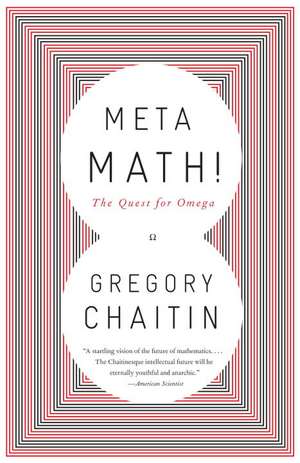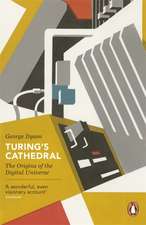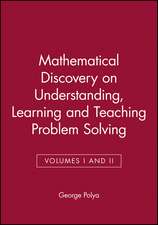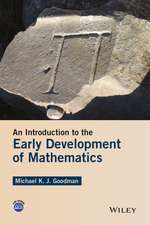Meta Math!: The Quest for Omega: PETER N. NEVRAUMONT BOOKS
Autor Gregory Chaitinen Limba Engleză Paperback – 31 oct 2006
Chaitin’s revolutionary discovery, the Omega number, is an exquisitely complex representation of unknowability in mathematics. His investigations shed light on what we can ultimately know about the universe and the very nature of life. In an infectious and enthusiastic narrative, Chaitin delineates the specific intellectual and intuitive steps he took toward the discovery. He takes us to the very frontiers of scientific thinking, and helps us to appreciate the art—and the sheer beauty—in the science of math.
Preț: 97.34 lei
Nou
Puncte Express: 146
Preț estimativ în valută:
18.63€ • 19.49$ • 15.47£
18.63€ • 19.49$ • 15.47£
Carte disponibilă
Livrare economică 13-27 martie
Preluare comenzi: 021 569.72.76
Specificații
ISBN-13: 9781400077977
ISBN-10: 1400077974
Pagini: 220
Dimensiuni: 134 x 202 x 16 mm
Greutate: 0.25 kg
Editura: Vintage Books USA
Seria PETER N. NEVRAUMONT BOOKS
ISBN-10: 1400077974
Pagini: 220
Dimensiuni: 134 x 202 x 16 mm
Greutate: 0.25 kg
Editura: Vintage Books USA
Seria PETER N. NEVRAUMONT BOOKS
Notă biografică
Gregory Chaitin works at the IBM Thomas J. Watson Research Center in Westchester County, New York, and is a visiting professor in the Computer Science Department of the University of Auckland, New Zealand. The author of eight previous books on mathematics, he lives in New York.
Extras
In his book Everything and More: A Compact History of Infinity, David Foster Wallace refers to Gödel as “modern math’s absolute Prince of Darkness” (p. 275) and states that because of him “pure math’s been in mid-air for the last 70 years” (p. 284). In other words, according to Wallace, since Gödel published his famous paper in 1931, mathematics has been suspended hanging in mid-air without anything like a proper foundation.
It is high time these dark thoughts were permanently laid to rest. Hilbert’s century-old vision of a static completely mechanical absolutely rigorous formal mathematics was a misguided attempt intended to demonstrate the absolute certainty of mathematical reasoning. It is time for us to recover from this disease!
Gödel’s 1931 work on incompleteness, Turing’s 1936 work on uncomputability, and my own work on the role of information, randomness and complexity have shown increasingly emphatically that the role that Hilbert envisioned for formalism in mathematics is best served by computer programming languages, which are in fact formalisms that can be mechanically interpreted—but they are formalisms for computing and calculating, not for reasoning, not for proving theorems, and most emphatically not for inventing new mathematical concepts nor for making new mathematical discoveries.
In my opinion, the view that math provides absolute certainty and is static and perfect while physics is tentative and constantly evolving is a false dichotomy. Math is actually not that different from physics. Both are attempts of the human mind to organize, to make sense of, human experience; in the case of physics, experience in the laboratory, in the physical world; and in the case of math, experience in the computer, in the mental mindscape of pure mathematics.
And mathematics is far from static and perfect; it is constantly evolving, constantly changing, constantly morphing itself into new forms. New concepts are constantly transforming math and creating new fields, new viewpoints, new emphasis, and new questions to answer. And mathematicians do in fact utilize unproved new principles suggested by computational experience, just as a physicist would.
And in discovering and creating new mathematics, mathematicians do base themselves on intuition and inspiration, on unconscious motivations and impulses, and on their aesthetic sense, just like any creative artist would. And mathematicians do not lead logical mechanical “rational” lives. Like any creative artist, they are passionate emotional people who deeply care about their art, they are unconventional eccentrics motivated by mysterious forces, not by money nor by a concern for the “practical applications” of their work.
I know, because I’m one of these crazy people myself! I’ve been obsessed by these questions for my whole life, starting at an early age. And I’ll give you an insider’s view of all of this, a firsthand report from the front, where there is still a lot of fighting, a lot of pushing and shoving, between different viewpoints. In fact basic questions like this are never settled, never definitively put aside, they have a way of resurfacing, of popping up again in transformed form, every few generations . . .
So that’s what this book is about: It’s about reasoning questioning itself, and its limits and the role of creativity and intuition, and the sources of new ideas and of new knowledge. That’s a big subject, and I only understand a little bit of it, the areas that I’ve worked in or experienced myself. Some of this nobody understands very well, it’s a task for the future. How about you?! Maybe you can do some work in this area. Maybe you can push the darkness back a millimeter or two! Maybe you can come up with an important new idea, maybe you can imagine a new kind of question to ask, maybe you can transform the landscape by seeing it from a different point of view! That’s all it takes, just one little new idea, and lots and lots of hard work to develop it and to convince other people! Maybe you can put a scratch on the rock of eternity!
Remember that math is a free creation of the human mind and as Cantor—the inventor of the modern theory of infinity described by Wallace—said, the essence of math resides in its freedom, in the freedom to create. But history judges these creations by their enduring beauty and by the extent to which they illuminate other mathematical ideas or the physical universe, in a word, by their “fertility.” Just as the beauty of a woman’s breasts or the delicious curve of her hips is actually concerned with childbearing, and isn’t merely for the delight of painters and photographers, so a math idea’s beauty also has something to do with its “fertility,” with the extent to which it enlightens us, illuminates us, and inspires us with other ideas and suggests unsuspected connections and new viewpoints.
Anyone can define a new mathematical concept—many mathematical papers do—but only the beautiful and the fertile ones survive. It’s sort of similar to what Darwin termed “sexual selection,” which is the way animals (including us) choose their mates for their beauty. This is a part of Darwin’s original theory of evolution that nowadays one usually doesn’t hear much about, but in my opinion it is much to be preferred to the “survival of the fittest” and the “nature red in tooth and claw” views of biological evolution. As an example of this unfortunate neglect, in a beautiful edition of Darwin’s The Descent of Man that I happen to possess, several chapters on sexual selection have been completely eliminated!
So this gives some idea of the themes that I’ll be exploring with you. Now let me outline the contents of the book.
Overview of the Book
Here’s our road to?
•In the second chapter I’ll tell you how the idea of the computer entered mathematics and quickly established its usefulness.
•In the third chapter, we’ll add the idea of algorithmic information, of measuring the size of computer programs.
•The intermezzo briefly discusses physical arguments against infinite-precision real numbers.
•The fifth chapter analyzes such numbers from a mathematical point of view.
•Finally the sixth chapter presents my information-based analysis of what mathematical reasoning can or cannot achieve. Here’s? In all its glory.
•A brief concluding chapter discusses creativity . . .
•And there’s a short list of suggested books, plays, and even musicals!
Now let’s get to work . . .
From the Hardcover edition.
It is high time these dark thoughts were permanently laid to rest. Hilbert’s century-old vision of a static completely mechanical absolutely rigorous formal mathematics was a misguided attempt intended to demonstrate the absolute certainty of mathematical reasoning. It is time for us to recover from this disease!
Gödel’s 1931 work on incompleteness, Turing’s 1936 work on uncomputability, and my own work on the role of information, randomness and complexity have shown increasingly emphatically that the role that Hilbert envisioned for formalism in mathematics is best served by computer programming languages, which are in fact formalisms that can be mechanically interpreted—but they are formalisms for computing and calculating, not for reasoning, not for proving theorems, and most emphatically not for inventing new mathematical concepts nor for making new mathematical discoveries.
In my opinion, the view that math provides absolute certainty and is static and perfect while physics is tentative and constantly evolving is a false dichotomy. Math is actually not that different from physics. Both are attempts of the human mind to organize, to make sense of, human experience; in the case of physics, experience in the laboratory, in the physical world; and in the case of math, experience in the computer, in the mental mindscape of pure mathematics.
And mathematics is far from static and perfect; it is constantly evolving, constantly changing, constantly morphing itself into new forms. New concepts are constantly transforming math and creating new fields, new viewpoints, new emphasis, and new questions to answer. And mathematicians do in fact utilize unproved new principles suggested by computational experience, just as a physicist would.
And in discovering and creating new mathematics, mathematicians do base themselves on intuition and inspiration, on unconscious motivations and impulses, and on their aesthetic sense, just like any creative artist would. And mathematicians do not lead logical mechanical “rational” lives. Like any creative artist, they are passionate emotional people who deeply care about their art, they are unconventional eccentrics motivated by mysterious forces, not by money nor by a concern for the “practical applications” of their work.
I know, because I’m one of these crazy people myself! I’ve been obsessed by these questions for my whole life, starting at an early age. And I’ll give you an insider’s view of all of this, a firsthand report from the front, where there is still a lot of fighting, a lot of pushing and shoving, between different viewpoints. In fact basic questions like this are never settled, never definitively put aside, they have a way of resurfacing, of popping up again in transformed form, every few generations . . .
So that’s what this book is about: It’s about reasoning questioning itself, and its limits and the role of creativity and intuition, and the sources of new ideas and of new knowledge. That’s a big subject, and I only understand a little bit of it, the areas that I’ve worked in or experienced myself. Some of this nobody understands very well, it’s a task for the future. How about you?! Maybe you can do some work in this area. Maybe you can push the darkness back a millimeter or two! Maybe you can come up with an important new idea, maybe you can imagine a new kind of question to ask, maybe you can transform the landscape by seeing it from a different point of view! That’s all it takes, just one little new idea, and lots and lots of hard work to develop it and to convince other people! Maybe you can put a scratch on the rock of eternity!
Remember that math is a free creation of the human mind and as Cantor—the inventor of the modern theory of infinity described by Wallace—said, the essence of math resides in its freedom, in the freedom to create. But history judges these creations by their enduring beauty and by the extent to which they illuminate other mathematical ideas or the physical universe, in a word, by their “fertility.” Just as the beauty of a woman’s breasts or the delicious curve of her hips is actually concerned with childbearing, and isn’t merely for the delight of painters and photographers, so a math idea’s beauty also has something to do with its “fertility,” with the extent to which it enlightens us, illuminates us, and inspires us with other ideas and suggests unsuspected connections and new viewpoints.
Anyone can define a new mathematical concept—many mathematical papers do—but only the beautiful and the fertile ones survive. It’s sort of similar to what Darwin termed “sexual selection,” which is the way animals (including us) choose their mates for their beauty. This is a part of Darwin’s original theory of evolution that nowadays one usually doesn’t hear much about, but in my opinion it is much to be preferred to the “survival of the fittest” and the “nature red in tooth and claw” views of biological evolution. As an example of this unfortunate neglect, in a beautiful edition of Darwin’s The Descent of Man that I happen to possess, several chapters on sexual selection have been completely eliminated!
So this gives some idea of the themes that I’ll be exploring with you. Now let me outline the contents of the book.
Overview of the Book
Here’s our road to?
•In the second chapter I’ll tell you how the idea of the computer entered mathematics and quickly established its usefulness.
•In the third chapter, we’ll add the idea of algorithmic information, of measuring the size of computer programs.
•The intermezzo briefly discusses physical arguments against infinite-precision real numbers.
•The fifth chapter analyzes such numbers from a mathematical point of view.
•Finally the sixth chapter presents my information-based analysis of what mathematical reasoning can or cannot achieve. Here’s? In all its glory.
•A brief concluding chapter discusses creativity . . .
•And there’s a short list of suggested books, plays, and even musicals!
Now let’s get to work . . .
From the Hardcover edition.
Recenzii
“A startling vision of the future of mathematics. . . . The Chaitinesque intellectual future will be eternally youthful and anarchic.”–American Scientist
“Math’s dark secret is out. . . . Chaitin explains why omega, a number he discovered thirty years ago, has him convinced that math is based on randomness.”
–Time Magazine
“Captivating. . . . With extraordinary skill and a gentle humor, Chaitin shares his profound insights.”
–Paul Davies, author of How to Build a Time Machine
“A clearly written and witty look at a difficult subject. . . . Chaitin explains with infectious enthusiasm how mathematics doesn't equal certainty.” –Science News
“Math’s dark secret is out. . . . Chaitin explains why omega, a number he discovered thirty years ago, has him convinced that math is based on randomness.”
–Time Magazine
“Captivating. . . . With extraordinary skill and a gentle humor, Chaitin shares his profound insights.”
–Paul Davies, author of How to Build a Time Machine
“A clearly written and witty look at a difficult subject. . . . Chaitin explains with infectious enthusiasm how mathematics doesn't equal certainty.” –Science News
Cuprins
Preface
Quotes by Leibniz/Galileo
Franz Kafka: Before the Law
One Introduction
Two Three Strange Loves: Primes/Gödel/LISP
Three Digital Information: DNA/Software/Leibniz
Four Intermezzo
Five The Labyrinth of the Continuum
Six Complexity, Randomness & Incompleteness
Seven Conclusion
Poem by Robert Chute
Poem by Marion Cohen
Further Reading
Appendix I
Appendix II
Index
Quotes by Leibniz/Galileo
Franz Kafka: Before the Law
One Introduction
Two Three Strange Loves: Primes/Gödel/LISP
Three Digital Information: DNA/Software/Leibniz
Four Intermezzo
Five The Labyrinth of the Continuum
Six Complexity, Randomness & Incompleteness
Seven Conclusion
Poem by Robert Chute
Poem by Marion Cohen
Further Reading
Appendix I
Appendix II
Index















